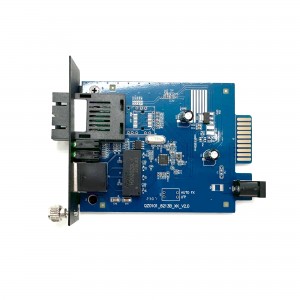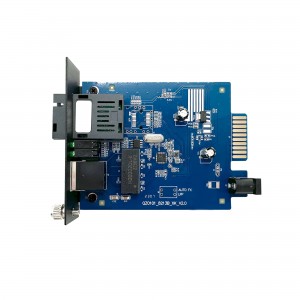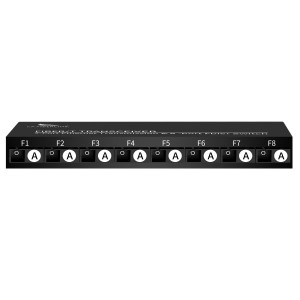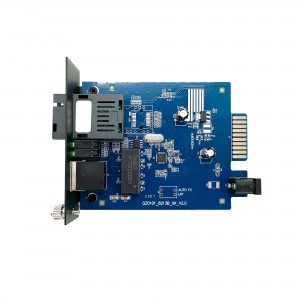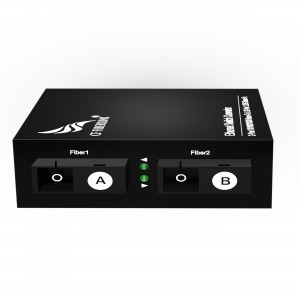6-port 10/100/1000M WDM Media Converter (Single-mode Single-fiber SC)
6-port 10/100/1000M WDM Media Converter (Single-mode Single-fiber SC)
Product Features:
Introduction to Gigabit Optical Transceivers: Revolutionizing Data Centers and Optical Networking
Welcome to Huizhou Changfei Optoelectronics Technology Co., Ltd., a leading manufacturer of industrial communication products in China. We are proud to present our latest innovation: the Gigabit 2-optical 4-electrical single-mode single-fiber transceiver, a cutting-edge solution designed to meet the growing demands of data centers and fiber optic networks.
At Huizhou YOFC, we understand the need for reliable and efficient communication solutions in today’s digital age. As enterprises continue to rely on data centers for critical operations, the need for high-performance networking equipment has never been greater. That’s why we developed this advanced Gigabit fiber optic transceiver, combining the latest technology with our industry expertise.
Our Gigabit Fiber Optic Transceivers are engineered with the utmost attention to detail to deliver superior performance in demanding environments. Its iron-clad design ensures durability, while the IP30 rating provides extra protection against dust and debris. In addition, it can be connected to an external power supply for flexible installation to ensure uninterrupted power supply.
With a focus on compatibility and versatility, our Gigabit fiber optic transceivers integrate seamlessly into existing infrastructure. Whether you need connectivity for cloud-managed industrial switches, PoE switches, or Ethernet switches, our transceivers are the ideal solution. It supports gigabit data transmission, is compatible with a variety of network devices, and provides reliable, high-speed connections.
But the advantage of our Gigabit fiber optic transceivers is not only in technical capabilities. In Huizhou Changfei, we are committed to providing customers with overall solutions. With our wide range of products, including fiber optic transceivers, wireless transmission equipment, etc., we provide a complete set of industrial communication products.
Our company’s core values center around innovation, quality and customer satisfaction. We are committed to becoming a world-class expert in industrial communications, continuously expanding our expertise in areas such as industrial Ethernet, industrial wireless and network integration. By providing systematic equipment, solutions and overall services, we aim to serve a wider range of users and meet their specific needs.
In summary, the Gigabit 2 Optical 4 Electrical Single Mode Single Fiber Transceiver is a game changer for data centers and fiber optic networks. With its iron case design, IP30 degree of protection and advanced features such as external power supply, it provides unmatched performance and reliability. Backed by Huizhou Changfei’s expertise and commitment to excellence, this transceiver is your gateway to seamless and efficient communications.
Experience the future of industrial communications – choose Huizhou Changfei’s Gigabit fiber optic transceivers now. Contact us to learn more about our products and solutions, or visit our website for details. Let’s change the way we connect and communicate in the digital world together.
Technical Parameter:
|
Model |
CF-2014GSW-3 | |
| Interface Characteristics | ||
|
Fixed Port |
4* 10/ 100/ 1000Base-T RJ45 port 2* 1000Base-X uplink SC fiber port |
|
|
Ethernet Port |
10/ 100/ 1000Base-T auto-sensing, full/half duplex MDI/MDI-X self-adaption |
|
|
Twisted Pair Transmission |
10BASE-T: Cat3,4,5 UTP(≤100 meter) 100BASE-T: Cat5e or later UTP(≤100 meter) 1000BASE-T : Cat5e or later UTP(≤100 meter) |
|
| Optical Port | Default optical module is single-mode single-fiber 3km, SC port | |
| Wavelength/Distance | A-end: RX1310nm / RX1550nm 0 ~ 40KM
B-end:RX1550nm/ RX1310nm 0 ~ 40KM |
|
| A-end: RX1490nm / RX1550nm 0 ~ 120KM
B-end:RX1550nm/ RX1490nm 0 ~ 120KM |
||
| Chip Parameter | ||
| Network Protocol | IEEE802.3 10BASE-T, IEEE802.3i 10Base-T,
IEEE802.3u 100Base-TX, IEEE802.3u 100Base-FX, IEEE802.3x IEEE802.3ab 1000Base-T;IEEE802.3z 1000Base-X; |
|
|
Forwarding Mode |
Store and Forward(Full Wire Speed) |
|
|
Switching Capacity |
12Gbps |
|
|
Buffer Memory |
8.92Mpps | |
|
MAC |
2K | |
|
LED Indicator |
Fiber | FX1(green)/FX2(green) |
| Data | 1-4 Green: Indicates network working status | |
| Power | PWR (green) | |
| Power | ||
| Working Voltage |
AC:100-240V |
|
|
Power Consumption |
Standby<1W, Full load<5W |
|
|
Power Supply |
DC:5V/2A industrial power supply |
|
| Lightning protection &Certification | ||
| Lightning protection | Lightning protection: 4KV 8/20us, Protection level: IP30 | |
| Certification | CCC;CE mark, commercial; CE/LVD EN60950;FCC Part 15 Class B; RoHS | |
| Physical Parameter | ||
| Operation TEMP | -20~+55°C;5%~90% RH Non condensing | |
| Storage TEMP |
-40~+85°C;5%~95% RH Non condensing |
|
| Dimension (L*W*H) | 142mm* 92mm*30mm | |
| Installation | Desktop | |
Product Size:
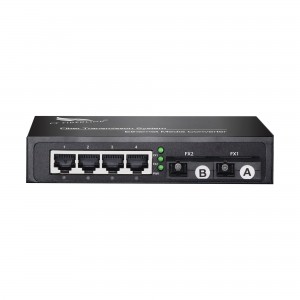
product application diagra:

How to choose a fiber optic transceiver?
Optical fiber transceivers break the 100-meter limitation of Ethernet cables in data transmission. Relying on high-performance switching chips and large-capacity caches, while truly achieving non-blocking transmission and switching performance, they also provide balanced traffic, isolation and conflict. Error detection and other functions ensure high security and stability during data transmission. Therefore, fiber optic transceiver products will still be an indispensable part of actual network construction for a long time. So, how should we choose fiber optic transceivers?
1. Port function test
Mainly test whether each port can work normally in the duplex state of 10Mbps, 100Mbps and half-duplex state. At the same time, it should be tested whether each port can automatically select the highest transmission speed and automatically match the transmission rate of other devices. This test can be included in other tests.
2. Compatibility test
It mainly tests the connection ability between the optical fiber transceiver and other devices compatible with Ethernet and Fast Ethernet (including network card, HUB, Switch, optical network card, and optical switch). The requirement must be able to support the connection of compatible products.
3. Cable connection characteristics
Test the fiber optic transceiver’s ability to support network cables. First, test the connection ability of Category 5 network cables with lengths of 100m and 10m, and test the connection ability of long Category 5 network cables (120m) of different brands. During the test, the optical port of the transceiver is required to have a connection capability of 10Mbps and a rate of 100Mbps, and the highest must be able to connect to a full-duplex 100Mbps without transmission errors. Category 3 twisted pair cables may not be tested. Subtests can be included in other tests.
4. Transmission characteristics (transmission loss rate of data packets of different lengths, transmission speed)
It mainly tests the packet loss rate when the optical fiber transceiver optical port transmits different data packets, and the connection speed under different connection rates. For the packet loss rate, you can use the test software provided by the network card to test the packet loss rate when the packet size is 64, 512, 1518, 128 (optional) and 1000 (optional) bytes under different connection rates. , the number of packet errors, the number of packets sent and received must be more than 2,000,000. Test transmission speed can use perform3, ping and other software.
5. The compatibility of the whole machine to the transmission network protocol
It mainly tests the compatibility of fiber optic transceivers to network protocols, which can be tested in Novell, Windows and other environments. The following low-level network protocols such as TCP/IP, IPX, NETBIOS, DHCP, etc. must be tested, and the protocols that need to be broadcast must be tested. Optical transceivers are required to support these protocols (VLAN, QOS, COS, etc.).
6. Indicator status test
Test whether the status of the indicator light is consistent with the description of the panel and the user manual, and whether it is consistent with the current status of the fiber optic transceiver.








